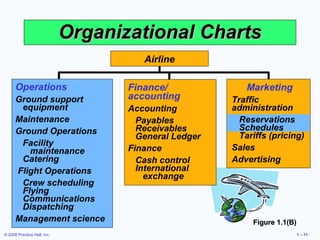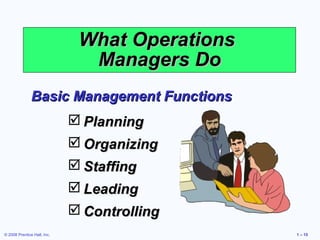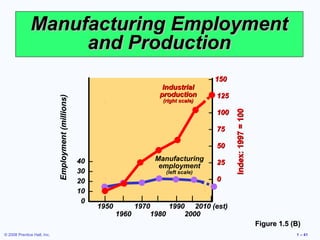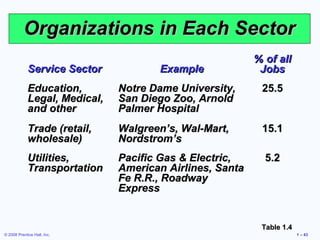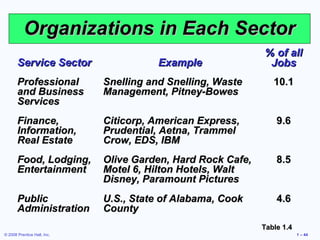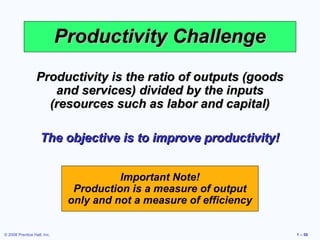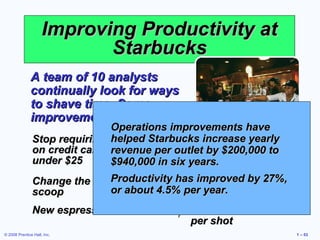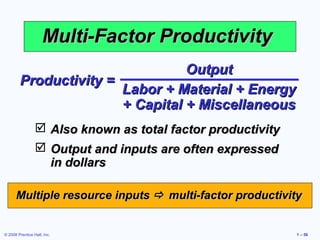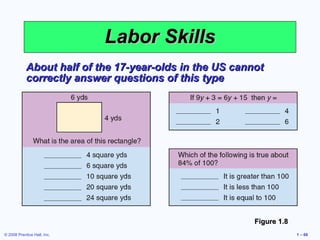Heizer 01
- 1. Operations Management Chapter 1 – Operations and Productivity PowerPoint presentation to accompany Heizer/Render Principles of Operations Management, 7e Operations Management, 9e © 2008 Prentice Hall, Inc. 1–1
- 2. Outline Global Company Profile: Hard Rock Cafe What Is Operations Management? Organizing to Produce Goods and Services Why Study OM? What Operations Managers Do How This Book Is Organized © 2008 Prentice Hall, Inc. 1–2
- 3. Outline - Continued The Heritage of Operations Management Operations in the Service Sector Differences between Goods and Services Growth of Services Service Pay Exciting New Trends in Operations Management © 2008 Prentice Hall, Inc. 1–3
- 4. Outline - Continued The Productivity Challenge Productivity Measurement Productivity Variables Productivity and the Service Sector Ethics and Social Responsibility © 2008 Prentice Hall, Inc. 1–4
- 5. Learning Objectives When you complete this chapter you should be able to: 1. Define operations management 2. Explain the distinction between goods and services 3. Explain the difference between production and productivity © 2008 Prentice Hall, Inc. 1–5
- 6. Learning Objectives When you complete this chapter you should be able to: 4. Compute single-factor productivity 5. Compute multifactor productivity 6. Identify the critical variables in enhancing productivity © 2008 Prentice Hall, Inc. 1–6
- 7. The Hard Rock Cafe First opened in 1971 Now – 121 restaurants in over 40 countries Rock music memorabilia Creates value in the form of good food and entertainment 3,500+ custom meals per day in Orlando How does an item get on the menu? Role of the Operations Manager © 2008 Prentice Hall, Inc. 1–7
- 8. What Is Operations Management? Production is the creation of goods and services Operations management (OM) is the set of activities that creates value in the form of goods and services by transforming inputs into outputs © 2008 Prentice Hall, Inc. 1–8
- 9. Organizing to Produce Goods and Services Essential functions: Marketing – generates demand Production/operations – creates the product Finance/accounting – tracks how well the organization is doing, pays bills, collects the money © 2008 Prentice Hall, Inc. 1–9
- 10. Organizational Charts Commercial Bank Operations Finance Marketing Teller Investments Loans Scheduling Security Commercial Check Clearing Real estate Industrial Collection Financial Transaction Accounting Personal processing Facilities Mortgage design/layout Auditing Vault operations Trust Department Maintenance Security Figure 1.1(A) © 2008 Prentice Hall, Inc. 1 – 10
- 11. Organizational Charts Airline Operations Finance/ Marketing Ground support accounting Traffic equipment Accounting administration Maintenance Payables Reservations Ground Operations Receivables Schedules General Ledger Tariffs (pricing) Facility maintenance Finance Sales Catering Cash control Advertising Flight Operations International exchange Crew scheduling Flying Communications Dispatching Management science Figure 1.1(B) © 2008 Prentice Hall, Inc. 1 – 11
- 12. Organizational Charts Manufacturing Operations Finance/ Marketing Facilities accounting Sales Construction; maintenance Disbursements/ promotion Production and inventory control credits Advertising Scheduling; materials control Receivables Sales Quality assurance and control Payables General ledger Market Supply chain management research Manufacturing Funds Management Tooling; fabrication; assembly Money market Design International Product development and design exchange Detailed product specifications Capital requirements Industrial engineering Stock issue Efficient use of machines, space, Bond issue and personnel and recall Process analysis Development and installation of production tools and equipment Figure 1.1(C) © 2008 Prentice Hall, Inc. 1 – 12
- 13. Why Study OM? OM is one of three major functions (marketing, finance, and operations) of any organization We want (and need) to know how goods and services are produced We want to understand what operations managers do OM is such a costly part of an organization © 2008 Prentice Hall, Inc. 1 – 13
- 14. Options for Increasing Contribution Finance/ Marketing Accounting OM Option Option Option Increase Reduce Reduce Sales Finance Production Current Revenue 50% Costs 50% Costs 20% Sales $100,000 $150,000 $100,000 $100,000 Cost of Goods – 80,000 – 120,000 – 80,000 – 64,000 Gross Margin 20,000 30,000 20,000 36,000 Finance Costs – 6,000 – 6,000 – 3,000 – 6,000 Subtotal 14,000 24,000 17,000 30,000 Taxes at 25% – 3,500 – 6,000 – 4,250 – 7,500 Contribution $ 10,500 $ 18,000 $ 12,750 $ 22,500 © 2008 Prentice Hall, Inc. 1 – 14
- 15. What Operations Managers Do Basic Management Functions Planning Organizing Staffing Leading Controlling © 2008 Prentice Hall, Inc. 1 – 15
- 16. Ten Critical Decisions Ten Decision Areas Chapter(s) Design of goods and services 5 Managing quality 6, Supplement 6 Process and capacity 7, Supplement 7 design Location strategy 8 Layout strategy 9 Human resources and 10, Supplement 10 job design Supply chain 11, Supplement 11 management Inventory management 12, 14, 16 Scheduling 13, 15 Maintenance 17 Table 1.2 © 2008 Prentice Hall, Inc. 1 – 16
- 17. The Critical Decisions Design of goods and services What good or service should we offer? How should we design these products and services? Managing quality How do we define quality? Who is responsible for quality? Table 1.2 (cont.) © 2008 Prentice Hall, Inc. 1 – 17
- 18. The Critical Decisions Process and capacity design What process and what capacity will these products require? What equipment and technology is necessary for these processes? Location strategy Where should we put the facility? On what criteria should we base the location decision? Table 1.2 (cont.) © 2008 Prentice Hall, Inc. 1 – 18
- 19. The Critical Decisions Layout strategy How should we arrange the facility? How large must the facility be to meet our plan? Human resources and job design How do we provide a reasonable work environment? How much can we expect our employees to produce? Table 1.2 (cont.) © 2008 Prentice Hall, Inc. 1 – 19
- 20. The Critical Decisions Supply chain management Should we make or buy this component? Who are our suppliers and who can integrate into our e-commerce program? Inventory, material requirements planning, and JIT How much inventory of each item should we have? When do we re-order? Table 1.2 (cont.) © 2008 Prentice Hall, Inc. 1 – 20
- 21. The Critical Decisions Intermediate and short–term scheduling Are we better off keeping people on the payroll during slowdowns? Which jobs do we perform next? Maintenance Who is responsible for maintenance? When do we do maintenance? Table 1.2 (cont.) © 2008 Prentice Hall, Inc. 1 – 21
- 22. Where are the OM Jobs? © 2008 Prentice Hall, Inc. Figure 1.2 1 – 22
- 23. Where are the OM Jobs? Technology/methods Facilities/space utilization Strategic issues Response time People/team development Customer service Quality Cost reduction Inventory reduction Productivity improvement © 2008 Prentice Hall, Inc. 1 – 23
- 24. Significant Events in OM Figure 1.3 © 2008 Prentice Hall, Inc. 1 – 24
- 25. The Heritage of OM Division of labor (Adam Smith 1776; Charles Babbage 1852) Standardized parts (Whitney 1800) Scientific Management (Taylor 1881) Coordinated assembly line (Ford/ Sorenson 1913) Gantt charts (Gantt 1916) Motion study (Frank and Lillian Gilbreth 1922) Quality control (Shewhart 1924; Deming 1950) © 2008 Prentice Hall, Inc. 1 – 25
- 26. The Heritage of OM Computer (Atanasoff 1938) CPM/PERT (DuPont 1957) Material requirements planning (Orlicky 1960) Computer aided design (CAD 1970) Flexible manufacturing system (FMS 1975) Baldrige Quality Awards (1980) Computer integrated manufacturing (1990) Globalization (1992) Internet (1995) © 2008 Prentice Hall, Inc. 1 – 26
- 27. Eli Whitney Born 1765; died 1825 In 1798, received government contract to make 10,000 muskets Showed that machine tools could make standardized parts to exact specifications Musket parts could be used in any musket © 2008 Prentice Hall, Inc. 1 – 27
- 28. Frederick W. Taylor Born 1856; died 1915 Known as ‘father of scientific management’ In 1881, as chief engineer for Midvale Steel, studied how tasks were done Began first motion and time studies Created efficiency principles © 2008 Prentice Hall, Inc. 1 – 28
- 29. Taylor’s Principles Management Should Take More Responsibility for: Matching employees to right job Providing the proper training Providing proper work methods and tools Establishing legitimate incentives for work to be accomplished © 2008 Prentice Hall, Inc. 1 – 29
- 30. Frank & Lillian Gilbreth Frank (1868-1924); Lillian (1878-1972) Husband-and-wife engineering team Further developed work measurement methods Applied efficiency methods to their home and 12 children! Book & Movie: “Cheaper by the Dozen,” book: “Bells on Their Toes” © 2008 Prentice Hall, Inc. 1 – 30
- 31. Henry Ford Born 1863; died 1947 In 1903, created Ford Motor Company In 1913, first used moving assembly line to make Model T Unfinished product moved by conveyor past work station Paid workers very well for 1911 ($5/day!) © 2008 Prentice Hall, Inc. 1 – 31
- 32. W. Edwards Deming Born 1900; died 1993 Engineer and physicist Credited with teaching Japan quality control methods in post- WW2 Used statistics to analyze process His methods involve workers in decisions © 2008 Prentice Hall, Inc. 1 – 32
- 33. Contributions From Human factors Industrial engineering Management science Biological science Physical sciences Information technology © 2008 Prentice Hall, Inc. 1 – 33
- 34. New Challenges in OM From To Local or national focus Global focus Batch shipments Just-in-time Low bid purchasing Supply chain partnering Lengthy product Rapid product development development, alliances Standard products Mass customization Job specialization Empowered employees, teams © 2008 Prentice Hall, Inc. 1 – 34
- 35. Characteristics of Goods Tangible product Consistent product definition Production usually separate from consumption Can be inventoried Low customer interaction © 2008 Prentice Hall, Inc. 1 – 35
- 36. Characteristics of Service Intangible product Produced and consumed at same time Often unique High customer interaction Inconsistent product definition Often knowledge-based Frequently dispersed © 2008 Prentice Hall, Inc. 1 – 36
- 37. Industry and Services as Percentage of GDP 90 − Services Manufacturing 80 − 70 − 60 − 50 − 40 − 30 − 20 − 10 − 0− Hong Kong Japan Spain France Czech Rep Mexico UK Australia Canada China Germany South Africa Russian Fed US © 2008 Prentice Hall, Inc. 1 – 37
- 38. Goods Versus Services Attributes of Goods Attributes of Services (Tangible Product) (Intangible Product) Can be resold Reselling unusual Can be inventoried Difficult to inventory Some aspects of quality Quality difficult to measure measurable Selling is distinct from Selling is part of service production Product is transportable Provider, not product, is often transportable Site of facility important for cost Site of facility important for customer contact Often easy to automate Often difficult to automate Revenue generated primarily Revenue generated primarily from tangible product from the intangible service © 2008 Prentice Hall, Inc. Table 1.3 1 – 38
- 39. Goods and Services Automobile Computer Installed carpeting Fast-food meal Restaurant meal/auto repair Hospital care Advertising agency/ investment management Consulting service/ teaching Counseling 100% 75 50 25 0 25 50 75 100% | | | | | | | | | Percent of Product that is a Good Percent of Product that is a Service Figure 1.4 © 2008 Prentice Hall, Inc. 1 – 39
- 40. Manufacturing and Service Employment 120 – 100 – Employment (millions) 80 – Service 60 – 40 – 20 – Manufacturing 0– | | | | | | | 1950 1970 1990 2010 (est) 1960 1980 2000 Figure 1.5 (A) © 2008 Prentice Hall, Inc. 1 – 40
- 41. Manufacturing Employment and Production – 150 Industrial production – 125 Employment (millions) (right scale) – 100 Index: 1997 = 100 – 75 – 50 40 – Manufacturing employment – 25 30 – (left scale) 20 – – 0 10 – 0 – | | | | | | | 1950 1970 1990 2010 (est) 1960 1980 2000 Figure 1.5 (B) © 2008 Prentice Hall, Inc. 1 – 41
- 42. Development of the Service Economy United States Canada France Italy Britain Japan W. Germany | | | | | 40 50 60 70 80 1970 2008 (est) Percent Figure 1.5 (C) © 2008 Prentice Hall, Inc. 1 – 42
- 43. Organizations in Each Sector % of all Service Sector Example Jobs Education, Notre Dame University, 25.5 Legal, Medical, San Diego Zoo, Arnold and other Palmer Hospital Trade (retail, Walgreen’s, Wal-Mart, 15.1 wholesale) Nordstrom’s Utilities, Pacific Gas & Electric, 5.2 Transportation American Airlines, Santa Fe R.R., Roadway Express Table 1.4 © 2008 Prentice Hall, Inc. 1 – 43
- 44. Organizations in Each Sector % of all Service Sector Example Jobs Professional Snelling and Snelling, Waste 10.1 and Business Management, Pitney-Bowes Services Finance, Citicorp, American Express, 9.6 Information, Prudential, Aetna, Trammel Real Estate Crow, EDS, IBM Food, Lodging, Olive Garden, Hard Rock Cafe, 8.5 Entertainment Motel 6, Hilton Hotels, Walt Disney, Paramount Pictures Public U.S., State of Alabama, Cook 4.6 Administration County Table 1.4 © 2008 Prentice Hall, Inc. 1 – 44
- 45. Organizations in Each Sector Manufacturing % of all Sector Example Jobs Manufacturing General Electric, Ford, 11.5 U.S. Steel, Intel Construction Bechtel, McDermott 7.9 Agriculture King Ranch 1.6 Mining Homestake Mining 0.4 Sector Percent of all jobs Service 78.6% Manufacturing 21.4% Table 1.4 © 2008 Prentice Hall, Inc. 1 – 45
- 46. New Trends in OM Past Causes Future Local or Reliable worldwide Global focus, national communication and moving focus transportation networks production offshore Batch (large) Short product life cycles Just-in-time shipments and cost of capital put performance pressure on reducing inventory Low-bid Supply chain competition Supply chain purchasing requires that suppliers be partners, engaged in a focus on the collaboration, end customer alliances, outsourcing Figure 1.6 © 2008 Prentice Hall, Inc. 1 – 46
- 47. New Trends in OM Past Causes Future Lengthy Shorter life cycles, Rapid product product Internet, rapid international development, development communication, computer- alliances, aided design, and collaborative international collaboration designs Standardized Affluence and worldwide Mass products markets; increasingly customization flexible production with added processes emphasis on quality Job Changing socioculture Empowered specialization milieu; increasingly a employees, knowledge and information teams, and lean society production Figure 1.6 © 2008 Prentice Hall, Inc. 1 – 47
- 48. New Trends in OM Past Causes Future Low-cost Environmental issues, ISO Environmentally focus 14000, increasing disposal sensitive costs production, green manufacturing, recycled materials, remanufacturing Ethics not Businesses operate more High ethical at forefront openly; public and global standards and review of ethics; opposition social to child labor, bribery, responsibility pollution expected Figure 1.6 © 2008 Prentice Hall, Inc. 1 – 48
- 49. New Trends in OM Global focus Just-in-time performance Supply chain partnering Rapid product development Mass customization Empowered employees Environmentally sensitive production Ethics © 2008 Prentice Hall, Inc. 1 – 49
- 50. Productivity Challenge Productivity is the ratio of outputs (goods and services) divided by the inputs (resources such as labor and capital) The objective is to improve productivity! Important Note! Production is a measure of output only and not a measure of efficiency © 2008 Prentice Hall, Inc. 1 – 50
- 51. The Economic System Inputs Processes Outputs Labor, The U.S. economic system Goods capital, transforms inputs to outputs and management at about an annual 2.5% services increase in productivity per year. The productivity increase is the result of a mix of capital (38% of 2.5%), labor (10% of 2.5%), and management (52% of 2.5%). Feedback loop Figure 1.7 © 2008 Prentice Hall, Inc. 1 – 51
- 52. Improving Productivity at Starbucks A team of 10 analysts continually look for ways to shave time. Some improvements: Stop requiring signatures Saved 8 seconds on credit card purchases per transaction under $25 Change the size of the ice Saved 14 seconds scoop per drink New espresso machines Saved 12 seconds per shot © 2008 Prentice Hall, Inc. 1 – 52
- 53. Improving Productivity at Starbucks A team of 10 analysts continually look for ways to shave time. Some improvements: Operations improvements have helped Starbucks increase yearly Stop requiring signatures Saved 8 seconds on credit card purchases outlet by $200,000 to revenue per per transaction under $25 $940,000 in six years. Change the size of the ice has improved by 27%, Productivity Saved 14 seconds scoop or about 4.5% per year. per drink New espresso machines Saved 12 seconds per shot © 2008 Prentice Hall, Inc. 1 – 53
- 54. Productivity Units produced Productivity = Input used Measure of process improvement Represents output relative to input Only through productivity increases can our standard of living improve © 2008 Prentice Hall, Inc. 1 – 54
- 55. Productivity Calculations Labor Productivity Units produced Productivity = Labor-hours used 1,000 = = 4 units/labor-hour 250 One resource input single-factor productivity © 2008 Prentice Hall, Inc. 1 – 55
- 56. Multi-Factor Productivity Output Productivity = Labor + Material + Energy + Capital + Miscellaneous Also known as total factor productivity Output and inputs are often expressed in dollars Multiple resource inputs multi-factor productivity © 2008 Prentice Hall, Inc. 1 – 56
- 57. Collins Title Productivity Old System: Staff of 4 works 8 hrs/day 8 titles/day Payroll cost = $640/day Overhead = $400/day Old labor 8 titles/day productivity = 32 labor-hrs © 2008 Prentice Hall, Inc. 1 – 57
- 58. Collins Title Productivity Old System: Staff of 4 works 8 hrs/day 8 titles/day Payroll cost = $640/day Overhead = $400/day Old labor 8 titles/day productivity = 32 labor-hrs = .25 titles/labor-hr © 2008 Prentice Hall, Inc. 1 – 58
- 59. Collins Title Productivity Old System: Staff of 4 works 8 hrs/day 8 titles/day Payroll cost = $640/day Overhead = $400/day New System: 14 titles/day Overhead = $800/day Old labor 8 titles/day productivity = 32 labor-hrs = .25 titles/labor-hr New labor 14 titles/day productivity = 32 labor-hrs © 2008 Prentice Hall, Inc. 1 – 59
- 60. Collins Title Productivity Old System: Staff of 4 works 8 hrs/day 8 titles/day Payroll cost = $640/day Overhead = $400/day New System: 14 titles/day Overhead = $800/day Old labor 8 titles/day productivity = 32 labor-hrs = .25 titles/labor-hr New labor 14 titles/day productivity = 32 labor-hrs = .4375 titles/labor-hr © 2008 Prentice Hall, Inc. 1 – 60
- 61. Collins Title Productivity Old System: Staff of 4 works 8 hrs/day 8 titles/day Payroll cost = $640/day Overhead = $400/day New System: 14 titles/day Overhead = $800/day Old multifactor 8 titles/day productivity = $640 + 400 © 2008 Prentice Hall, Inc. 1 – 61
- 62. Collins Title Productivity Old System: Staff of 4 works 8 hrs/day 8 titles/day Payroll cost = $640/day Overhead = $400/day New System: 14 titles/day Overhead = $800/day Old multifactor 8 titles/day productivity = $640 + 400 = .0077 titles/dollar © 2008 Prentice Hall, Inc. 1 – 62
- 63. Collins Title Productivity Old System: Staff of 4 works 8 hrs/day 8 titles/day Payroll cost = $640/day Overhead = $400/day New System: 14 titles/day Overhead = $800/day Old multifactor 8 titles/day productivity = $640 + 400 = .0077 titles/dollar New multifactor 14 titles/day productivity = $640 + 800 © 2008 Prentice Hall, Inc. 1 – 63
- 64. Collins Title Productivity Old System: Staff of 4 works 8 hrs/day 8 titles/day Payroll cost = $640/day Overhead = $400/day New System: 14 titles/day Overhead = $800/day Old multifactor 8 titles/day productivity = $640 + 400 = .0077 titles/dollar New multifactor 14 titles/day productivity = $640 + 800 = .0097 titles/dollar © 2008 Prentice Hall, Inc. 1 – 64
- 65. Measurement Problems Quality may change while the quantity of inputs and outputs remains constant External elements may cause an increase or decrease in productivity Precise units of measure may be lacking © 2008 Prentice Hall, Inc. 1 – 65
- 66. Productivity Variables Labor - contributes about 10% of the annual increase Capital - contributes about 38% of the annual increase Management - contributes about 52% of the annual increase © 2008 Prentice Hall, Inc. 1 – 66
- 67. Key Variables for Improved Labor Productivity Basic education appropriate for the labor force Diet of the labor force Social overhead that makes labor available Maintaining and enhancing skills in the midst of rapidly changing technology and knowledge © 2008 Prentice Hall, Inc. 1 – 67
- 68. Labor Skills About half of the 17-year-olds in the US cannot correctly answer questions of this type Figure 1.8 © 2008 Prentice Hall, Inc. 1 – 68
- 69. Investment and Productivity 10 Percent increase in productivity 8 6 4 2 0 10 15 20 25 30 35 Percentage investment © 2008 Prentice Hall, Inc. 1 – 69
- 70. Service Productivity Typically labor intensive Frequently focused on unique individual attributes or desires Often an intellectual task performed by professionals Often difficult to mechanize Often difficult to evaluate for quality © 2008 Prentice Hall, Inc. 1 – 70
- 71. Productivity at Taco Bell Improvements: Revised the menu Designed meals for easy preparation Shifted some preparation to suppliers Efficient layout and automation Training and employee empowerment © 2008 Prentice Hall, Inc. 1 – 71
- 72. Productivity at Taco Bell Improvements: Results:the menu Revised Designed meals for easy preparation Shifted some preparationto 8 seconds Preparation time cut to suppliers Management span of control Efficient layout and automation increased from 5 to 30 Training and employee empowerment In-store labor cut by 15 hours/day Stores handle twice the volume with half the labor Fast-food low-cost leader © 2008 Prentice Hall, Inc. 1 – 72
- 73. Ethics and Social Responsibility Challenges facing operations managers: Developing and producing safe, quality products Maintaining a clean environment Providing a safe workplace Honoring community commitments © 2008 Prentice Hall, Inc. 1 – 73
Editor's Notes
- Using this and subsequent slides, you might go through in more detail the decisions of Operations Management. While greater detail is provided by these slides than the earlier one, you may still decide to have the students contribute examples from their own experience.











